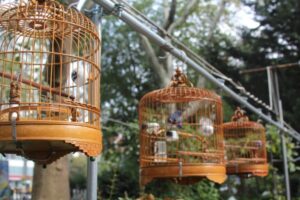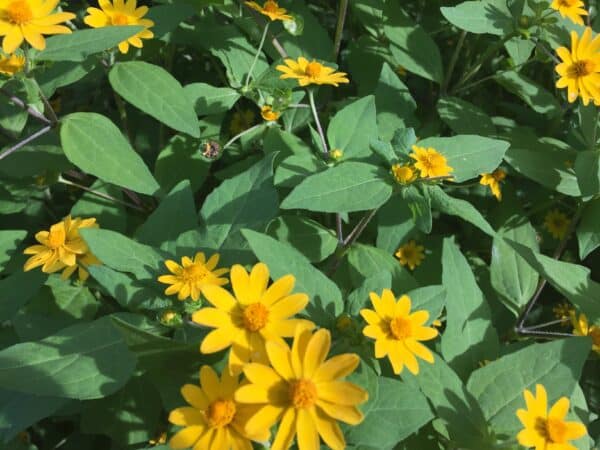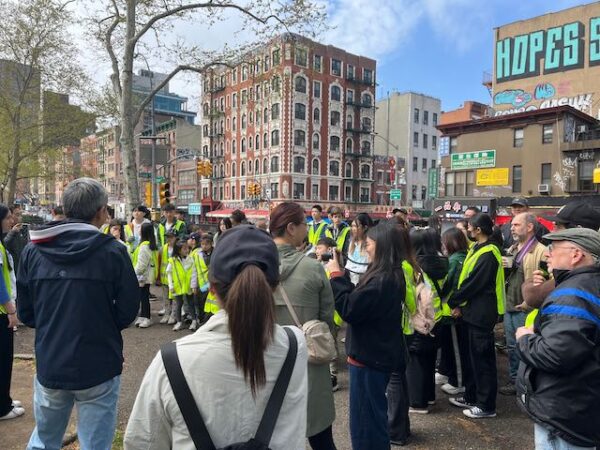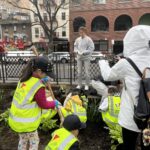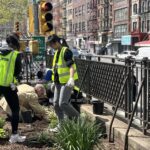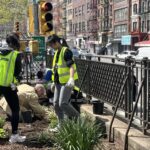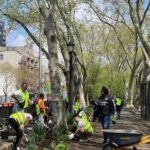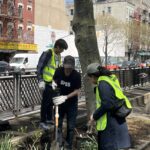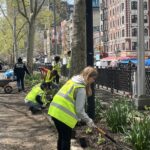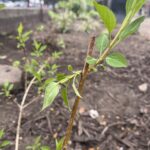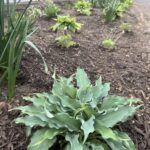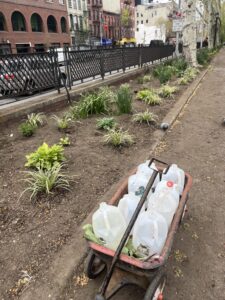We encourage all of our communities here to go out to see all of our gardens here – and learn about the histories of each new and welcomed addition to our communities: their hardships and their contributions.
We have three key garden plots that currently exist, are tended and represent communities here, as well as efforts to build unity of purpose and welcome. We are planning many others to honor all the legacies here.
We have literally decades of work and experience building, maintaining, and preserving gardens here (below is some of that history).
We build these in part to address some of the tensions here, and in part because we want to honor all histories here.
These are the current gardens we’ve built and cared for, legacy gardens enshrined here:
Sebastiaen de Britto Garden Acknowledges this entire area’s history as The Land of the Blacks 1647.
Hua Mei Bird Garden 1995 three men, a Chinese banker and two former waiters, approached Anna Magenta, who, with Federico Sabini, had started the four decade old Forsyth Conservancy.
The Ribbon Garden or Sunflower Garden created in response to the Anti-Asian violence here.
The Lanape Middle Garden (Planned) to honor the presence of Lenapehoking/Welikia/Mannahatta.
Earth Day Memorial Plot to be rebuilt.
Details Below:
Sebastiaen de Britto Garden 1647
Acknowledges this entire area’s history as The Land of the Blacks. See the Tenement Museum’s article. Landscape Ideas from African American Swept garden of the Southern USA
And the extensive work of Tauba Auerbach on the history of “The Land of the Blacks” *
This plot was part of a larger area “granted in 1647 to “Bastiaen Negro”, born Sebastiaen de Britto, a formerly enslaved man of African descent who had been kidnapped in Santo Domingo by the Dutch West India Company. Once a ship captain, de Britto held Captain status amongst the other enslaved people in New Amsterdam. He was given this land and his full freedom, alongside several other enslaved persons who were granted adjacent land and partial freedom under the “half -freedom plan”. These Black farmers were positioned north of the Wall street (where a wall was soon built) and used as a buffer between the Dutch to the south and the Lenape to the north.” Tauba Auerbach did extensive work uncovering the full local history. (see below)
History of African American Women’s Gardens and the Sebastiaen de Britto Garden
“Guided by my heritage of a love of beauty and a respect for strength—in search of my mother’s garden, I found my own.”
Alice Walker, In Search of our Mother’s Gardens
The design and working history is to recreate as possible (given climate differences) the post-Civil War Gardens of Black women based on the work of Dianne D. Glave Assist. Professor in the African American Studies Department at Loyola Marymount University, and an African American and environmental historian.
“TO PLANT their flower and vegetable gardens, African American women used their hands—darkly creviced or smoothly freckled; their arms—some wiry, others muscled; and their shoulders and backs—one broad and another thin. They dropped small seeds into the soil with their veined hands. They wrapped their arms around freshly cut flowers to decorate tables in their homes. They bent their shoulders and backs to compost hay, manure, and field stubble, and transplanted plants from the woods into their own yards. These women developed a unique set of perspectives on the environment by way of the gardens they grew as slaves and then as freedwomen. They continued these practices and exercised these perspectives into the early twentieth century. Rural African American women then joined these traditional ways of gardening with horticultural practices they learned from Home Demonstration Service agents and from the special programs developed in African American schools in the South.”
“A swept yard is a lawn-free style of front garden that has its roots in West Africa. They were maintained to be weed and debris free with handmade stick brooms.
“Yard sweeping. The yard was also the heart of the home since the inside quarters were not cooled and much of the work of living took place outside.“
Photo courtesy, African Americans at Mars Bluff, South Carolina found via Francis Marion University
Plantings:
‘a garden so brilliant with colors, so original in Design’
Rural African American Women, Gardening, Progressive Reform and the Foundation of an African American Environmental Perspective.
-Dianne D. Glave – Jstor
“petunias, buttercups, verbenas, day lilies, cannas, chrysanthemums, iris, and phlox planted in the ground, old tires, bottles, planters, and tubs. They placed shrubs—roses, azaleas, altheas, forsythia, crepe myrtle, spirea, camellias, nandina, and wild honeysuckle—throughout the yard. Azaleas and roses were most commonly planted. The dogwood, oak, chestnut, pine, red maple, black locust, sassafras, hickory, willow, cottonwood, and redbud dotted the landscape. They chose ornamental plants that were self-propagating, along with annuals that were generally self-seeding. Colorful combinations of blues, reds, pinks, oranges, whites, and yellow often clashed with little or no sequencing. Placement was generally informal, where the gardeners could find space. A mix of color and placement resulted in a lack of symmetry and formal design. African Americans, including the women, simply could not afford to buy several shrubs, plants or flowers at the same time to create such symmetry.”…
“Women’s roles were transformed from slavery to sharecropping. Jacqueline Jones observes that African American men reinforced gender roles by hunting and fishing during slavery. Men were primarily responsible for cultivating the tiny household garden plots allotted to families by the slaveholder. They practiced conservation, tilling their own vegetable plots when time off from the slaveholder’s tasks allowed. Dating back to the antebellum period, [enslaved people] used organic farm methods such as composting, when they took or were given the opportunity to grow their own gardens. A Louisiana [enslaved] gardener also built birdhouses from hollowed gourds to attract nesting birds that protected vegetables from insects and other pests. The birdhouses, a modern fixture in suburban backyards, provided shelter for the birds that served as a natural pest control. …
One [formerly enslaved woman] vividly remembered the leafy plants and bright blossoms encircling the family cabin: “Us live in a log house wid a little porch in front and de mornin’ glory vines use to climb ’bout it. When they bloom, de bees would come hummin’ ’round and suck the honey out de blue bells on the vines. I members dat well ’nough, dat was a pleasant memory.’” Many women probably “dressed up” the exterior of their homes with blossoms.10
Women expanded their roles by cultivating family vegetable patches, continuing to plant ornamental and flower gardens. Gardens served as a source of food for their families, a means of enhancing their homes, and, in some circumstances, a small source of revenue. Women improved their families’ nutrition by planting homegrown vegetables and saved money by limiting the purchase of store goods. African American women supplemented the pantry with turnip and collard greens, staples in their gardens. The women also created visual appeal..with flowers and ornamental plants outside their homes.”
****
Hua Mei Bird Garden The Hua Mei Bird sanctuary was created in 1995, It was a part of the four decade old Forsyth Conservancy (along with the other three plots – de Britto/Ribbon/Center plot). “In 1995, three men, a Chinese banker and two former waiters, approached Anna Magenta, who, with Federico Sabini, had started the Forsyth Street Garden Conservancy in 1994 to improve the park. With her help, they petitioned the Parks Department, and in 1995, the Hua Mei Bird Garden was hatched. Bird gardens are common in China, and there are even restaurants that cater to patrons with their birds in tow.”
Tony was using the drinking fountain filling small water bottles. Now uses fire hydrant with small jugs. Tommy Chen, Tony, and others have maintained this plot for over 40 years.
photo Lee Elson
Former Council Member Margaret Chin, at our request, came and interpreted for the birders (none speak fluent English) to ensure we had all of their requests correctly noted.
Tommy Chen Long-time organizer of the Birders
Interpreting by former Council Member Margaret Chin, visit with Tony the Birders
***
The Ribbon Garden or Sunflower Garden was created in response to the Anti-Asian violence here, including two brutal deaths, through funding provided by University Settlement’s ROAR festival. It was the coming together of every racial group here/immigrants/residents/homeless people/ rich/poor/middle class/police/youth/elders etc. to create ribbons of hope for the park, their families/everyone.
More photos: search site “Sunflower Project” or “ROAR Festival”
The Lanape Middle Garden (Planned)
Slated to honor the presence of Lenapehoking/Welikia/Mannahatta
This Land: Lenapehoking/Welikia/Mannahatta and later New Amsterdam/Manhattan
***
Earth Day Memorial Plot
Earth Day Celebration and Honoring the Life of Christina Yuna Lee with Chinatown Partnership, NYC Parks, Partnership for Parks, M’Finda Gardeners, Sol Sharp Music, Chinese Progressive Association, 5th Pcts Youth Explorers, 50 Bowery, GF55 Architects, Neighbors/Volunteers/ Sara Roosevelt Park Community Coalition and many others..
With the Chinatown Partnership and Wellington Chen to honor the life of Christina Yuna Lee who was brutally murdered on Chrystie Street. The garden didn’t survive (no nearby water source – our volunteers tried mightily) but we hope to recreate it after the renovation.
The Long Histories of the Gardens South Delancey to Grand Street in Sara Roosevelt Park.
-Our decades of advocacy and relationships made with former Council Member Chin (and former Borough President Gale Brewer) enabled the lion’s share of the funding ($15 Million) for this South Delancey to Grand funding. This is also true of the Rivington Playground Playground. (We gratefully acknowledge The Alliance and the Mayor’s office for added funding!).
-The NYC Parks Department and NYC abandoned this park in the 80’s.
We didn’t.
We took the park back as a neighborhood and with the help of elected representatives and the police department. At that time (the early 80’s) the gardens here were reactivated. The Forsyth Conservancy created the four current gardens in this section (these were formerly GreenThumb gardens) and some of their members still live here.
-We worked hard on the resolution for this section to ensure the work of this community didn’t get erased by well-intended, but unaware partners.
-We have spent over $3000 of a grant for plants, and bought others paid for by volunteers, and generous donations from Bronx nursery, specifically for these plots. We’ve planted and replanted many times. We’ve had plants stolen, slept on, trampled, gardens used as a latrine or shooting gallery or weed-whacked by well-intentioned Park workers. We freed up tree beds and repurposed those Belgian blocks for these sites to outline the plant areas and pathways to help the public and park workers delineate the beds more clearly. Our experience has shown that when we clarify the area – people tend to respect that.
-We were thrilled with the outcome of a garden behind the Broome Street building thanks to the Alliance’s advocacy for it.
-Grateful for the overall design which makes this park more beautiful, accessible and safer.
-We (this Coalition) were, for decades, the ONLY gardeners who worked in this park. We are all volunteers. We are unpaid, local, and from every walk of life here.
-We fight for NYC Parks funding with the Playfair Coalition
-The Alliance has continue a focused clean-up and planting days in the Hester /Grand areas.
-In this section we work with MKG volunteers, 5th Pct Youth Explorers, University Settlement, Tenement Museum staffers, resident volunteers, Buro Happold volunteers, etc. – under the supervision of a volunteer gardener Kate Fitzgerald who has worked in this park for 40+ years.
-We have cared for these gardens for decades – despite there being NO water source. It means we have to schlepp, by wagon and shopping cart, jugs of water every week to water plants here from the MKG across the street or the water fountain.
-Given tightening budgets, it is unlikely Parks will be able to hire a dedicated gardener here who learns the area and knows how to tend the plantings.
-We intend to continue gardening here and (as is our usual way) encourage local community members, classrooms and organizations to ‘take on’ the plots. This helps educate all of us, gives the community a stake in their neighborhoods and their city, promotes a sense of earned ownership and sharing and understanding what a “public good” means in practice.
-We do not want easily maintained/generic gardens with a look that isn’t connected to who is here and who has been here.
With thanks to Partners:
Our Local Elected Officials: US Congressman Goldman, NYS Senator Kavanagh, NYS Assemblymember Lee, Council Member Marte, MBP Levine.
NYC Parks Department: Jamil Phillips, former Manhattan Commissioner Perez, and Park Workers.
The Tenement Museum, longtime partner – two blocks away, has also offered to play a role in ensuring that we have tours that stop by and give this history. The Museum may offer our local schools visits to these gardens and to the Museum itself (racially diverse and low-income students, many ELL students in the high schools that are located at both ends of this long narrow park)
University Settlement and the ROAR Festival
The 5th Precinct Youth Explorers and PO Randy Chan and PO Shaneek Smith
These Communities
FABnyc
Sea of Galilee Church
GreenMap
Remote Theater Project
BRC Senior Center Kim Fong and Staff
Wellington Chen and the Chinatown Partnership
M’Finda Kalunga Garden Community and all the volunteer gardeners here
Rob Watson Founder Leeds Certification
Buro Happold volunteers
City Relief
AAFE
Alliance
Boy Scouts
Bkind
Bowery Football Club
Chinese Progressive Association
New Deal
Thomas Ong Commander and American Legion,
and many more
*Regarding the de Britto in particular: Most of the homeless here are African American men. A number of these men are consistent volunteers who tend the park with the Coalition. We are often thanked by other homeless people simply for continuing to care for these tougher to maintain gardens that had been given up on. Most of the Park workers are African American, our Coalition Vice President lives across the street with her two sons who are African American. This matters to our efforts to build respect for every group, and ultimately, unity here.
Side Note: We have had numerous complaints/questions about what looks/sounds like exploratory digs (for water sources or simply testing the state of collapse beneath?). Could we have some kind of signage and notification on what is going on for the community (much as we do for the East River Projects/Southern shore projects)?









